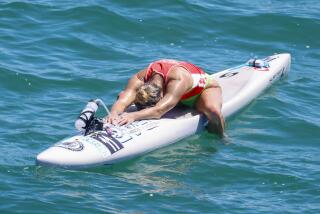Sails Pitch Detracting From Cup
- Share via
In New Zealand, where one can wager on sailboat racing, the odds are about even that there will be an America’s Cup race today. Maybe the next three days.
But don’t bet on it. For eight consecutive days since falling behind Switzerland’s Alinghi, 3-0, in the best-of-nine series, Team New Zealand has been accused of creatively working the system in cahoots with race director Harold Bennett, either to delay the inevitable outcome or find the ideal weather conditions for launching a comeback.
“It’s stopped the momentum of the event,” Tony Thomas, head of the America’s Cup organizing committee, told Associated Press.
And to put the event even more on edge, New Zealand postal workers in Wellington, the capital well south of the sailing scene in Auckland, discovered letters containing cyanide crystals and white powder addressed to the U.S. Embassy and the British and Australian High Commissions. Anti-terror police issued a public warning because the letters referred to “actions” that could occur if Iraq were attacked. The letters mentioned the America’s Cup races.
For foreigners, that might increase a sense of urgency to get the racing over with and get out of there. It surely ratchets up the pressure on Bennett in the center of the storm. Nobody blames him for the weather, only for not dealing with it very well.
You thought Bud Selig had a tough call at baseball’s All-Star game? Bennett has had one almost every day in his quest for conditions that satisfy both teams, especially the one that hired him: the Royal New Zealand Yacht Squadron, the current custodian of the Cup.
One day it’s too calm, the next too windy, and if the wind’s blowing just right then it’s still too shifty. On some days forecasts have been so grim that racing has been called off before the boats left the harbor -- then, occasionally, went out anyway to practice.
“It’s part of the normal sailboat racing game,” said Peter Isler, now home after serving as navigator for Team Dennis Conner. “It seems silly when I came back to San Diego and we were starting races in winds much lighter than we’d ever have started in the Louis Vuitton Cup [challenger trials].
“It’s also crazy that there’s only a two-hour-and-15-minute window in which they can have a start -- 1:15 until 3:30 -- without mutual consent, [and] I think there’s been a mistake in how early the blowoff time is. They should have been more patient. There were probably days they could have raced had they [waited].”
Isler doesn’t accuse Bennett of being a homer, although that may place him in the minority.
“I know Harold. I’m sure he has the best interest of Team New Zealand in mind. But this isn’t a guy who’s going to play favorites to the extreme. He was probably trying to run the best races he could. [But] he started out being pretty picky, and now I’m sure he looks back and thinks, gosh, I could have started a race or two and been farther along.”
Isler, who studied meteorology at Yale, blames Auckland’s location more than any bias by Bennett for the problems.
“It’s a dynamic situation where weather systems are constantly moving around it. They’re getting blown out now because there’s a semitropical storm just blasting ‘em on the east side.”
Even in normal times it’s a challenge to sailors.
“Except for the northeast sea breeze, there is no steady wind direction,” Isler said. “The Hauraki Gulf is surrounded by land except for that northeast window, and so even on the best south-southwest days there are 10- to 15-degree shifts, and 30-plus-degree shifts aren’t unusual.”
In the view of Bennett, they also aren’t conducive to a fair sailing contest -- even if the Alinghi guys said they were willing to take their chances.
Tom Ehman, a longtime America’s Cup principal who was with San Francisco’s Oracle BMW team this time, doesn’t entirely blame Bennett, either. Calling races before boats had left port would also include spectator boats.
“There are a thousand boats, big and small, out there in six-foot seas, and you have safety considerations,” Ehman said by phone from Auckland. “A lot of the criticism is from frustration, and there’s some gamesmanship -- by both sides.
“I’m not sure that what [Team New Zealand] is doing in being a little cagey about when they start races hasn’t backfired. They’ve lost some support locally and have taken a lot of heat from the international press.”
The Kiwis have been especially averse to racing in shifty breezes, which suggests to many observers that they believe they have the faster boat, despite being down, 3-0. A lucky wind shift can help a slower boat.
But why should the competitors be allowed to make the call in the first place?
“This charming aspect of the Cup is antiquated,” Ehman said. “It’s time to change. For the sake of television, for the sake of spectators, for the sake of just sport, you’ve got to be prepared to race and willing to race.”
More to Read
Sign up for The Wild
We’ll help you find the best places to hike, bike and run, as well as the perfect silent spots for meditation and yoga.
You may occasionally receive promotional content from the Los Angeles Times.






